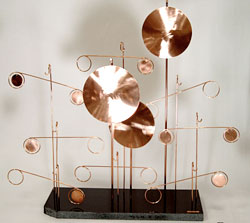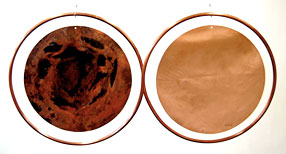Copper in the Air
 Balance in the Universe copper sculpture by Gary Christopherson.
Balance in the Universe copper sculpture by Gary Christopherson.Photograph by Gary Christopherson
Most copper artists tend to work with traditional sculpture, but for Gary "Chris" Christopherson, his approach has been a bit lighter on its feet. Working from his studio and gallery in University Park, Maryland, Chris creates both copper mobiles and stabiles.
It was only in college that he discovered art when his then-girlfriend was required to create an Alexander Calder-type mobile. But she was having difficulty with it so Christopherson offered his help and found that he really enjoyed it. Though he began with Alexander Calder as an inspiration, he wanted to take off in a different direction. "How does one do things in a more interesting, different and hopefully better way?" he asks.
His first mobiles were all copper wire based.
"What got me going on copper is that copper has a number of characteristics that make it fun to work with," he says. "It's easy to use from a bending perspective and it is malleable."
He has crafted well over 200 mobiles and stabiles using all manner of copper; from tubing, to wire, rod, sheet and plate, to create light and delicate mobiles, some stationary sculpture and, well, everything in between. But unlike many copper artists, he will not chemically apply patinas.
"The great thing about copper is that it changes, going from bright copper to red to brown and then blue-green patina, naturally," he admits of his copper and wood pieces. "I also wanted to work with a natural material and copper pairs well with wood, American black walnut is what I use, and there's a brown-red tone to the wood which compliments the copper."
 Forever copper sculpture.
Forever copper sculpture. Photograph by Gary Christopherson
His sculptures are meant to be interacted with by the viewer and are meant to be gently touched. Some mobiles make sounds when moved by wind or people; some remain silent. Some move physically; some move conceptually.
Christopherson does not apply a clear coat on either his interior or exterior work.
"Generally it will slowly but surely patina on its own," he says. "The lacquer strategy works fine if you don't have movable copper material," as he does with his mobiles. "Outside, for example it will wear where ever the two contact points are with two pieces of copper," he says. Therefore the lacquer wears off and needs to be re-applied and ultimately affects the art. A natural maturation is best for his approach. Though chemical patinas are off limits, heat application is another matter. "The differential application of heat is something I play around with, and I feel it's within the natural characteristics of copper. It's an issue of how something is applied in a non-chemical way," he says.
He sources all his various copper materials from ThyssenKrupp since they have a vast selection. Coming up in 2012, Chris will have a group showing at the Ratner Museum in Bethesda, MD, something he doesn't do often.
"I owe a lot to copper, It's been a terrific material to work with and has allowed me do a lot of wonderful things in the art world," he says. "Copper has been great to me."
Resources:
Also in this Issue:
- Jimenez Sculpture: The Beauty Is in The Copper Detail
- Copper in the Air
- Greg Wilbur: Using An Ancient Process to Create Contemporary Artworks
- The Combustible Side of Copper Art
- Large Salvador Dali art collection on display in Austin
